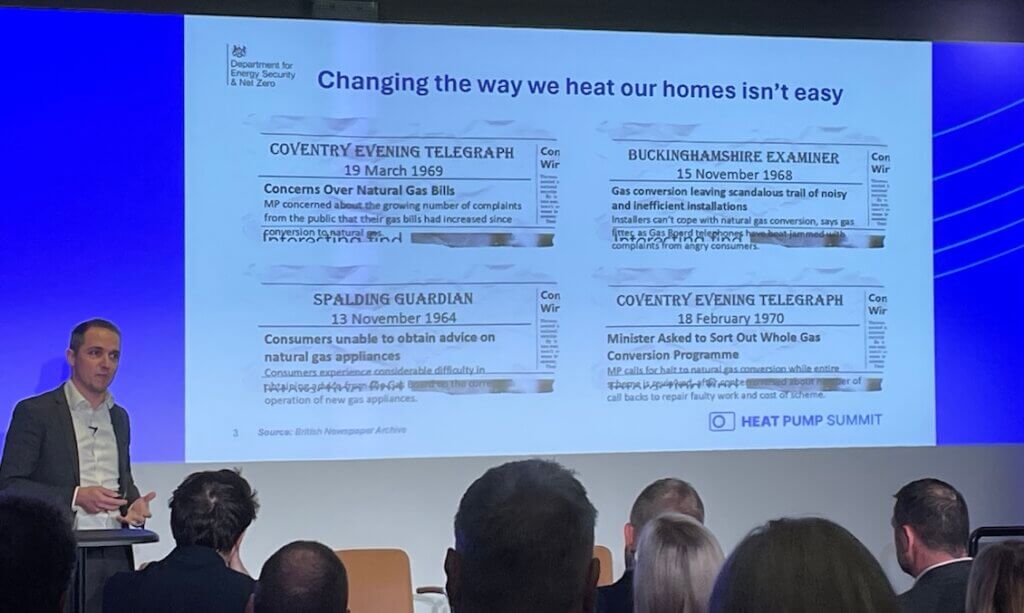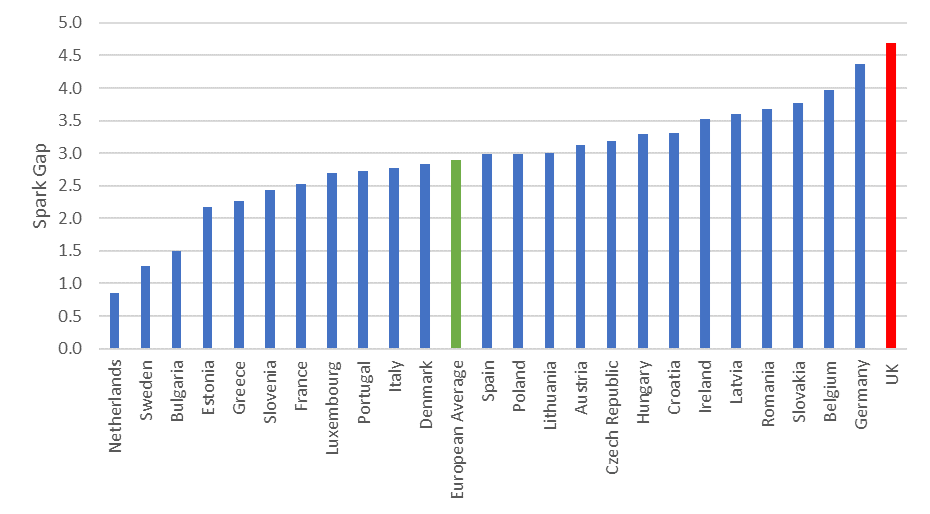Heat Pump Summit 2024
The Low Carbon Hub team recently had the opportunity to take part in the inaugural Heat Pump Summit 2024 at the Blavatnik School of Government in Oxford, which was truly inspiring. This gathering was a valuable experience, allowing us to engage with the latest developments in heat pump technology sector.
In this blog post, we’ll share our team’s key takeaways, including insights from the Nordic countries, the dispelling of common heat pump myths, and approaches to overcoming the Spark Gap.

The unstoppable heat pump revolution
With the challenges of climate change and energy security at the forefront of government agendas worldwide, the future for gas boilers is clear: their days are numbered, as can be seen by developments in most other European countries.
However, the UK has had a slow start in adopting heat pumps, with just over 200,000 certified installations to date. While this marks a good beginning, it falls short of the government’s own target of 600,000 installations per year by 2028. In fact, to fully replace all gas boilers, the UK will need to be installing 1.7 million heat pumps annually by 2036 — replacing the 23 million gas boilers currently providing homes and workplaces with central heating and hot water.
Yet, amidst these challenges, there is a glimmer of hope. The summit was an invaluable opportunity to hear from the UK’s leading heat pump experts about the latest developments in this rapidly maturing industry. As speaker after speaker shared their organisations’ ambitions and challenges, several key points kept emerging, one of the key messages to emerged was that the heat pump revolution is now unstoppable.
Everybody is a critic
Dr. Matthew Aylott, Electrification of Heat Policy Lead at the Department for Energy Security and Net Zero, offered valuable government insights into the rollout of heat pumps. One of the most memorable highlights was his exploration of people’s natural reluctance to embrace change, which added an amusing and interesting twist to the discussion.
He took us back to the 1960s, a time when the idea of piping natural gas directly into homes was met with scepticism and apprehension. Dr. Aylott underscored this observation with some historical newspaper clippings. Yet who complains about gas in homes these days?

In more recent times, scepticism also surrounded the introduction of the internet. It stumbled through its infancy with clunky dial-up connections and those noisy modems some of us will remember well. Yet, consider where we are today – with most of us carrying the internet in our pockets via our mobile phones!


When it comes to the roll-out of heat pumps, not much has changed. Today, sceptics are still resisting the inevitable transformation of our energy use, from polluting carbon emissions to clean electricity. But already, as with all previous technological changes, the momentum has now become unstoppable. In fact, the added urgency of climate change and energy sustainability will only speed up the transition over the next decade.
Debunking heat pump myths
Dr. Jan Rosenow, Director of European Programs at the Regulatory Assistance Project, is sometimes known as “Professor Heatpump” for his inspiring speeches and optimistic outlook.
A simple yet powerful point he emphasised is that while the UK currently installs around 1.7 million gas boilers annually, switching to 1.8 million heat pumps for just two years could eliminate the need for Russian gas imports for home heating, giving the UK greater energy security.
Jan Rosenow makes it very clear that NO country has made progress on heat pump transition without a strong package of policies – which are largely absent in the UK.
Passionate about debunking negative myths surrounding heat pumps, Dr Rosenow actively fact-checks misinformation commonly spread by mainstream media to provide accurate information and counter misinformation effectively, and for this has created an insightful article titled 18 misleading myths about heat pumps.
Tesla made EVs cool. Until then they were very niche. Once the product became cool, cool people started advocating the product, which powered the transition to EV cars. We need to make heat pumps cool.
Tom Callow (EV man), Head of Corporate Communications at myenergi
Scaling up
With two-thirds of homes in Norway already equipped with heat pumps and Sweden following closely behind, Matt Isherwood, Service Operations Director at Aira UK, made a bold statement: “The boiler is the enemy” as he announced the imminent opening of the company’s heat pump giga-factory, aiming to produce 500,000 units annually. This declaration marks a significant shift in the industry’s attitude.

As Norway leads the charge, with Sweden not far behind, heat pumps are quickly becoming the preferred choice for efficient heating solutions.
With the UK lagging far behind in heat pump installation, now is the perfect moment to scale up adoption. As the threat of climate change looms and the urgent need to reduce carbon emissions grows, the UK has a golden opportunity to speed up its transition to heat pump technology.
As key figures in the heat pump industry, such as Tamsin Lishman from the Kensa Group, highlighted throughout the summit, there is now a collective effort by the industry to ramp up the scale of production. Backed by massive investments, the drive is to increase market competitiveness, lower unit costs, and, combined with customer financing options and warranties supported by remote monitoring, it promises to be a revolutionary year ahead for the sector.
Matt adds, “We all agree that heat pumps are the right technology to decarbonise heating. Now it’s time to deliver!” He summed it up by declaring the urgent need to decarbonise our homes and workplaces: ‘Decarbonising the UK, one house at a time.’


The Nordic clean heating lessons
Following the oil crisis in the 1970s, Nordic countries started a remarkable journey towards energy self-sufficiency. Unlike much of Europe, which returned to business as usual, nations like Norway, Finland, and Sweden recognised the urgent need to reduce their reliance on fossil fuels. This foresight laid the groundwork for what would later become a leading example of sustainable heating solutions.
At the heart of this transformation was the widespread adoption of heat pumps, a technology celebrated for its efficiency and positive environmental impact. Yet, the success of heat pumps in the Nordic region wasn’t solely due to technological advancements. It was the result of a combination of strategic policy interventions and societal dedication.
One of the most significant policy measures was the implementation of carbon taxation, which encouraged the shift away from fossil fuels. Additionally, government incentives and regulations played pivotal roles. Norway’s decision to ban the use of heating oil in buildings stands out as a decisive action that sped up the adoption of heat pump technology.
Furthermore, the Nordic success story also highlights the importance of consumer protection and engagement. Initiatives such as the establishment of complaint resolution bodies, such as the Swedish “Heat Pump Court” established in 1989 ensured transparency and accountability, building confidence in the transition process.
Crucially, the Nordic experience highlights the necessity of a comprehensive policy approach. Relying solely on economic incentives or regulatory measures isn’t sufficient. Instead, a well-coordinated mix of policies, including financial support, regulation, and informational campaigns, is vital for driving widespread adoption.
As countries worldwide confront the challenges of climate change and energy transition, the Nordic model offers invaluable insights. Policymakers in regions where heat pumps are still emerging can find inspiration in the Nordic experience, leveraging its successes and learning from its setbacks.
“There is public confusion which heat pump to choose. We need to make it simple. We need to bring prices down with mass retrofit projects.”
Andrew Sissons, Deputy Mission Director at Nesta
Closing the spark gap
The significance of the Spark Gap was quite a revelation to our team attending the summit, and is an issue that certainly needs to be addressed as part of making heat pumps more cost-effective to operate.
The Spark Gap, also known as Spark Ratio or Spark Spread, refers to the disparity in prices between gas and electricity per kilowatt-hour (kWh). In the UK, electricity is significantly more expensive than gas, hindering the cost-effectiveness of carbon-reducing technologies like heat pumps.
Despite heat pumps being much more efficient than traditional gas boilers, the high cost of electricity limits potential savings on energy bills. This disparity is driven by factors such as reliance on gas-powered plants for electricity generation and taxes on pollution from power plants, which inflate electricity prices.
To make carbon reduction options like heat pumps more accessible, urgent action is needed to reduce the Spark Gap. Proposed measures include removing extra charges from electricity bills and restructuring electricity pricing to lessen its dependence on gas prices. Addressing the Spark Gap is critical for speeding up the transition to cleaner energy and meeting net-zero targets.

Grid edge co-ordinators
Andrew Sissons, Deputy Mission Director at Nesta, made an interesting point about the transition from early adopters to the early majority phase in adopting new technology like heat pumps. As more people considered this option, they naturally became more cautious and looked for reassurance.
He suggested that there was a role to play for Grid Edge Co-ordinators, working closely with community groups to provide support and guidance. Sissons also suggested the need for funded coordination at the street level for a successful heat pump rollout, echoing the role of the Grid Edge Coordinators that had previously already been trialled in Project LEO.
His suggestion for a ‘Visit a Heat Pump’ scheme, like open house events that have been held in Oxfordshire for domestic retrofit projects, is another idea worth exploring with community groups to promote greater awareness and uptake of heat pumps.


Turning up the heat
The inaugural Heat Pump Summit 2024 has been truly inspiring. It reflected a maturing industry that has found its direction and is gaining momentum. With a new wave of innovation and technology promising to transform the world, cutting carbon emissions and promoting sustainability, there was a real sense of optimism and purpose.
Oxfordshire transition pioneers
As a leader in community energy generation at the grid edge, Low Carbon Hub has been at the forefront of promoting the transition to clean energy for over a decade. Through our partnerships and services aimed at promoting measures such as energy efficiency, and heat pump adoption, we’re driving the transition towards sustainable energy solutions.
If you’re interested in learning more about heat pumps, we offer services tailored to both domestic and commercial properties:
For domestic properties: Cosy Homes Oxfordshire will provide expert advice and tailored retrofit solutions to help homeowners determine if heat pump technology is suitable for your home.
For commercial properties: Energy Solutions Oxfordshire (ESOx) carries out on-site workplace energy efficiency assessments for businesses, schools, and community spaces. The ESOx team can advise you on how implementing a heat pump can help reduce energy bills and lower carbon emissions.
Together, these services are empowering individuals and businesses to implement energy efficiency measures and reduce their environmental impact, one property at a time.

